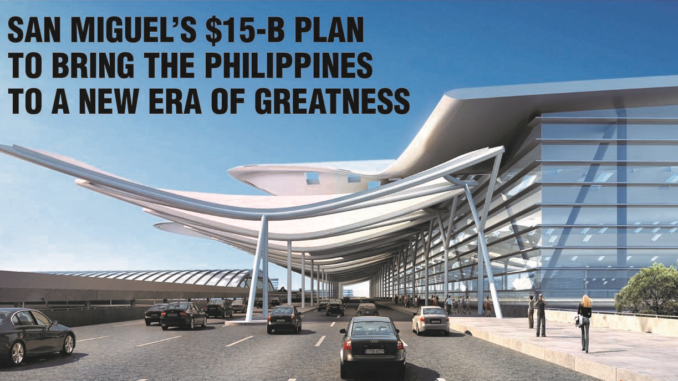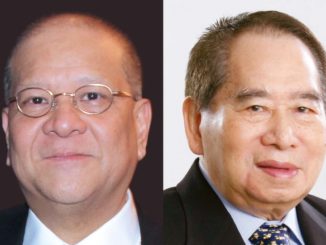
This year, San Miguel Corp.’s P735-billion massive airport project in Bulacan will be subject to a Swiss challenge.
I don’t know why that kind of project approval by the government is named after the Swiss (maybe because Switzerland is a neutral country and does not favor anyone, except the Pope who is guarded by Swiss guards) but it is a good system for a project proponent to proceed with his project, after everyone envious or ambitious is given a chance to match it or fails to match it.
I don’t know of any Philippine company, Filipino or foreign, which can match the parameters of the San Miguel airport project, in terms of:
- Cost (P735.63 billion or at least $14 billion with no government borrowings)
- Contiguous area of project site (2,500 hectares)
- Number of runways (four; even six if government wants it)
- Delivery date (five years for the first two runways)
- Distance from the present Naia (27 kms north)
- Technology (state of the art, involving the world’s largest and best endowed suppliers of services, materials and equipment like steel, engineering, construction prowess, and finance)
- Advanced planning (San Miguel Corp. president Ramon S. Ang first proposed the airport in 2013 to the government and since Day One has prepared every aspect of planning, engineering, financing, management team, and project execution and thus enjoys what you call the first proponent or first mover advantage and a short learning curve once notice to proceed is given)
- Ancillary amenities like a seaport, a cargo hub, an industrial estate (where locators can expect cheap electricity and water since SMC is Luzon’s biggest electricity producer and will operate Luzon’s biggest water resource), an above and underground link from Bulacan to Manila, Makati, and the present Naia plus several connecting expressways
- Project track record (SMC operates 100 industrial plants, 55% of Luzon’s toll roads, and the bulk of Luzon’s power plants)
- Size (SMC is the country’s largest conglomerate in sales which this year will exceed P950 billion, 5% of the national output of goods and services or GDP, the most profitable with profits hitting P65 billion to P70 billion this year, has the biggest retail network involving some 700,000 sari-sari stores, and
- Reputation (Today, the world knows only of three things about the Philippines: Rodrigo Duterte, the president and strong leader; Manny Pacquiao, the boxing champion, and San Miguel, the conglomerate and its beer.)
Why San Miguel for our airport?
In the 2004 movie “Troy,” Achilles, played by Brat Pitt, slays the giant warrior of a man with a single leap and a single stroke of his sword onto the enemy’s left shoulder and then asks the roaring crowd: “Is there no one else?” The slain warrior’s king, of course, doesn’t like what he saw, but is advised by his commander, “We need him.”
We need San Miguel’s airport like we needed to rewrite our history from one of mediocrity to one of greatness.
All our lives, we have lived by a culture of smallness. We celebrate defeats like the Fall of Bataan but not victories like the conquest of Lapu-Lapu of the arrogant intruder Magellan (Do we have a Lapu-Lapu holiday?).
The best marketing gimmicks are in sachets or tingi and not wholesale. We still plan of travelling fast, in 30 minutes, the 50 kms. from Balintawak to Malolos while other nations are planning to go to the moon or Mars, millions of miles and light years away. Still, the Japanese will do it for us, not our own Filipino engineers, and by using cheap Filipino labor. We think connecting Clark and Subic with 71 kms. of railway is great when in fact, the Philippines used to enjoy the longest railway system in the entire Southeast Asia.
The Philippines built Asean’s first expressway (the NLEX today), the first elevated railway (LRT1), the first aqueduct, and Asia’s first water and sewerage system (Nawasa) when most Asians had no access to potable water and treated sewage.
Export powerhouse
In the 1970s, the Philippines was an export powerhouse with export earnings ten times those of South Korea, Taiwan, and Hong Kong.
By 1981, Hong Kong ($21.8 billion) had 3.8x more exports than the Philippines ($5.72 billion), South Korea ($21.25 billion) 3.7x, and Taiwan ($22.6 billion), 3.9x.
By 2016, Hong Kong’s exports ($502.5 billion) were 8.9x those of the Philippines’ $56 billion, South Korea ($495.4 billion) 8.8x, and Taiwan ($280.3 billion) 5x.
With poor infra, the Philippines also missed three waves of foreign investments that flowed into Southeast Asia in the 1980s, 1990s, and 2000s. These investments fueled the economic miracles of Thailand and Malaysia, today, the top two tourist destinations in ASEAN.
The lesson then is: When you invest in tourism infrastructure as big as airports, you boost not just tourism. You also boost investments. When the two go together, you have all-around prosperity.
No wonder, the per capita incomes of Thailand in purchasing parity US dollars is $16,070, while Malaysia’s is $26,900, far more than the Philippines’ $9,400 despite this country’s having been previously (until 1970 at least), Southeast Asia’s richest economy.
Thus, the San Miguel airport brings us back to a bygone era of greatness when Filipinos were builders of men, of economies, and of nations. We should think like the Vietnamese. In five years, Vietnam became the biggest rice exporter and biggest coffee exporter. It cut its unemployment to half of ours.
The San Miguel airport has many benefits. They include:
- Massive employment. Manila will attract 20-million tourists. Every tourist arrival creates 2.5 million jobs so easily 30-million jobs, enough to solve the country’s unemployment five times. A five-star hotel needs four workers per room.
- Additional one percentage point to GDP growth rate. If normal growth is 7%, it becomes 8%.
- It will cut cost of air travel drastically. A one-hour flight in the Philippines is about $300; in Vietnam it’s $50; in Europe it’s 60 euros.
- It will cut cargo cost by 90%, from $10 per kilo to $1. Electronics requires just in time assembly and delivery which an airport can provide.
- It will solve Metro Manila’s traffic which costs us P3 billion per day.
- It will revitalize industry and make the Philippines an export powerhouse again (electronics and transport parts are our No. 1 export).
- If the 625 hectares of old Naia are sold as a real estate deal it will generate P2 trillion, enough to build Manila’s most modern business city (Makati’s Central Business District is only 100 hectares; that of Fort Boni 250 has.), and enough to jumpstart President Duterte’s “Build, Build, Build” and solve poverty almost overnight. His Free College costs only P60 billion a year. College education is the best way to lick poverty.
- It will not drain government resources. Financing will be handled by San Miguel whose current borrowings is only one-third of its allowable debts.
- It will make Duterte a great president.
- It will make the Philippines truly a great nation, overhaul our culture of smallness, and make every Filipino proud of himself.
But will San Miguel make money? Of course, but not much—only 7% return per year. SMC will recover its cost in 15 years. But then San Miguel has always believed in profit with honor. More importantly, San Miguel’s business is not beer or any other product or service. It is development.



